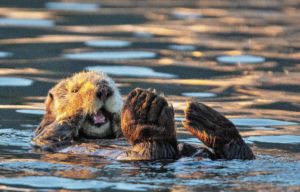Here is the article I wrote for the Last Frontier Magazine about expeditions I shared with our guests in October and November. It’s my first attempt at writing a story since college many years ago and this is my first ever blog.
The only place on earth you can observe Humpback whales work as a team bubble net feeding is here in the pristine, nutrient-rich waters of Alaska.
This most impressive act of cooperative feeding was on display from early October to Mid-November in the Eastern Channel and up towards Silver Bay in front of the aptly named whale Park of Sitka, AK.
 The Alp-like peaks of Tongass National Forest and the crimson-streaked dormant Mt Edgecumbe volcano provided the backdrop as we watched a pod of 15 -20 humpback whales cruises back and forth across 500’ deep waters searching for the huge bait-balls of krill. When they found their prey, the leader called to the team synchronizing the pod mates’ dive and actions.
The Alp-like peaks of Tongass National Forest and the crimson-streaked dormant Mt Edgecumbe volcano provided the backdrop as we watched a pod of 15 -20 humpback whales cruises back and forth across 500’ deep waters searching for the huge bait-balls of krill. When they found their prey, the leader called to the team synchronizing the pod mates’ dive and actions.
As Captain of, A Whale’s Song Expeditions, my guests and I had breathtaking courtside seats while the whale’s supplied the play-by-play announcing of their activities. Eavesdropping on their communication with our on-board hydrophone, we would detect the pitch of feeding calls from the leader abruptly getting higher and louder. Each time I heard this I knew my guests would soon be astonished as the whale’s heads would erupt with huge mouths open, throat grooves bulging with fish and seawater flushing through their baleen plates. In seconds several hundred Glaucous Gulls would quickly arrive screaming and swarming the upwelling waters full of krill with some of the more courageous gulls seeming to steal the crustaceans from the surfaced open mouths. On the occasion these engagements arose adjacent to our vessel, the noise of the whale’s grunts, calls and whistling exhales united with the gulls crying, although quite loud had a natural soothing effect on our souls.
My guests and I were fortunate to have this scenario play out as often as twenty times during many of our 3-hour expeditions while being treated to other acrobatic humpback displays as we watched them breach, lobtail, flipper slap, and spy hop. Watching the graceful and athletic performances of these 20 plus ton beautiful creatures instinctually serves to remind and motivate all of us for the sustained need for conservation, education, and research to help protect the precious marine environment
October through January are ideal times to delight in this behavior as Megaptera novaeangliae gorge themselves before making their migratory journey to the calving and breeding grounds in the shallow, clear, warm waters of Maui Hawaii. Mid-March through the end of April is another exciting time to see bubble net feeding when the herring spawn, “Sac Roe” concentrates the whale pods again and stimulates the feeding activities of all the marine mammals around Sitka.
Witnessing bubble-net feeding behavior make jaws drop, and exhausts camera and cell phone batteries from the constant shooting of this display, no matter how many times one has seen whales. It’s no wonder Sitka was dubbed, “The Jewel of the Pacific.”
#whales #whalewatching #whalephotography #hydrophone #sitkaalaska #bubblenetfeeding #wildlifetour